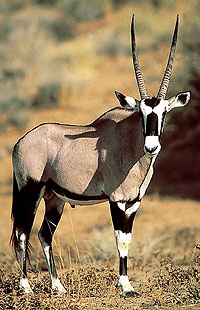 |
| Language | Name |
| Afrikaans | Gemsbok |
| Ndebele | Nkukhama |
| Tswana | Kukama |
| Damaro | Gaeb |
| Herero | Ndumo |
|
|
|
|
Aptly referred to as the “Spirit of the Desert”, the silhouette of the gemsbok, shimmering on the horizon through the midday heat, is an image synonymous with Africa. Heavily built, with a short, stocky neck and distinctive long, rapier-like horns, the gemsbok is unlike any other African antelope. Well-defined black and white facialmarkings as well as black bands running along each flank above a pure-white belly, stand out in stark contrast against the grey/fawn colour of the body. Black patches on the upper-parts of the legs and top of the rump, a black stripe down the front of the neck and a long black horse-like tail completes its striking appearance.
Subtle differences between males and females make the two sexes difficult to distinguish from one another. Females are generally slighter in build than their male counterparts. The bull’s horns are much shorter and more robust.
Gemsbok, it is believed, once enjoyed a wide distribution throughout southern and northeast Africa. However, due to dramatic climate transformation during the Pliocene era, about 11 million years ago, all this changed. This was a period during which the central parts of the continent, it is thought, were a lot dryer.
Today gemsbok are found in the arid north-west of the subregion, throughout Namibia, Botswana, marginally into Zimbabwe and extending northwards into Angola.
A second population, comprising two seperate subspecies, O g callotis and O g beisa are found in East Africa. The former is found in Kenya, south of the Tana river as well as in northern Tanzania. The latter, however is found as far north as the Sudan and Ethiopia southwards through Uganda and Kenya.
Essentially a species of open, arid country, gemsbok occur in open grassland, savannah and light open woodland. In some parts of the southern Namib desert, they are found on the dunes and sand fields as well as the mountainous northern regions.
Highly gregarious, large herds of up 300 animals have been recorded in the Namib desert, but this is unusual.Gemsbok form mixed herds numbering about 15 individuals. Whilst adult males display dominance over all females, the herd is led by a high-ranking cow, but controlled by the alpha bull, who normally takes his position to the rear of the herd. In larger herds, several other bachelor males, which are tolerated by the territorial bull, may be present.
Where there is a dependable food supply, solitary individual males are often encountered, each defending their own territories.
Gemsbok are well-adapted to their waterless waistland habitat. Although gemsbok will readily drink water when available, when it is scarce they supplement their primarily grass diet with melons and will dig for roots, bulbs and tubers. Often, gemsbok, under these extreme drought conditions, limit their day-time activities to the barest minimum, feeding mainly during the night and early morning, when plants contain the most moisture.
| Minimum Scores |
Rowland Ward
40 inches | SCI
88 inches |
|
Although gemsbok do not display any set breeding pattern, peaks in calving correspond to rainfall. Courtship and mating are the prerogative of the territorial male within the herd and after a 264 day gestation period, females drop a single calf. Males reach sexual maturity at about five years of age whereas females start breeding as young as two years of age.
|